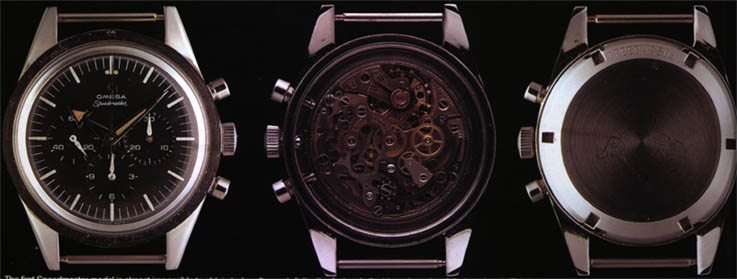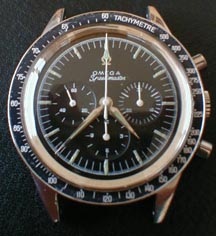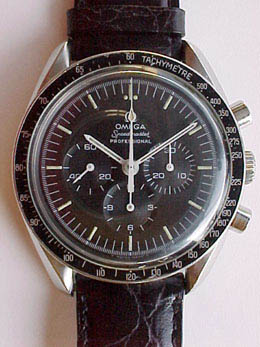










RARE COLLECTION - OMEGA SPEEDMASTER PROFESSIONAL CHRONOGRAPH THE SAME MODEL WORN BY ASTRONAUTS WHO WERE THE FIRST MEN LANDED ON THE MOON. OMEGA 17 JEWELS MANUAL WINDING CAL.861 SERIAL NO. 32834987 CIRCA 1970, A YEAR AFTER APOLLO 11 LANDED ON THE MOON.
WILL KEEP IT AS MY PERSONAL COLLECTION BECAUSE OF DIFFICULTY TO FIND AND RARITY OF THIS WATCH BUT I'M WILLING TO PART WITH IT FOR RM6,500 AND NON NEGOTIABLE
SOLD TO REPEAT BUYER, MR VUDUC FROM BELGIUM
WILL KEEP IT AS MY PERSONAL COLLECTION BECAUSE OF DIFFICULTY TO FIND AND RARITY OF THIS WATCH BUT I'M WILLING TO PART WITH IT FOR RM6,500 AND NON NEGOTIABLE
SOLD TO REPEAT BUYER, MR VUDUC FROM BELGIUM
History of the Omega Speedmaster
The first chronograph with the name "Speedmaster" appeared in 1957. And that is pretty much the same Speedmaster as we know it today. On first sight.
Through the years, a lot of things were changed on this watch. For instance, the word "Professional" in 1966 when it was approved for NASA use (more on that later), in 1968 they (Omega) changed the movement from a calibre 321 (with "schaltrad") to a cheaper to produce, but more accurate calibre 861 (with shuttlesystem). Both movements were based on Lemania movements. Todays Speedmaster Professional watch still uses the 861 movement. Before 1957, there were also some chronographs (since 1942) using the 321 calibre but they had no "Speedmaster" written on the dial.
The first Speedmaster (1957) looked like this :

Foto scanned from Time Capsule
This model, referenced as CK2915 was created in 1957 and is nowadays hard to find. The watch has the 1/5th seconds, minute and hours markings in white on a black dial. The counters are located on 3 o' clock, 6 o' clock and 9 o' clock. The bezel contains engraved tachymetre figures (not very clear on the photo above).
The caseback is the one with the Seamaster logo because this type of watchcase was originally developed for the Seamaster (triple-shield case to enable it to withstand high pressure). The diameter of the watch-case was 39mm.
The caseback is the one with the Seamaster logo because this type of watchcase was originally developed for the Seamaster (triple-shield case to enable it to withstand high pressure). The diameter of the watch-case was 39mm.
The movement used in this watch was a 27 CHRO C12, better known as the Cal.321 (manual winding).
The 27 stands for 27mm, the CHRO stands for "chronograph" and C12 indicates that the watch has an 12-hour counter (at 6 o'clock).This movement was designed by Albert Piguet (who worked for Lemania during those days) in 1942. It took Omega 15 years to produce this watch as it was released in 1957.
The 27 stands for 27mm, the CHRO stands for "chronograph" and C12 indicates that the watch has an 12-hour counter (at 6 o'clock).This movement was designed by Albert Piguet (who worked for Lemania during those days) in 1942. It took Omega 15 years to produce this watch as it was released in 1957.
In 1959 they produced a slightly modified Speedmaster, known as CK2998. The watch-case diameter expanded from 39mm to 40mm and they added a so called O-ring gasket around the push buttons.

CK2998
Until 1966 there were no big changes on the watch (look for the "Differences through the years" in the menu for details). The NASA bought a Speedmaster along with some other chronograph watches to test it for use on their missions. Read all about it in the "Nasa tests" section of this website. After long and rigirous testing of the watch, the NASA concluded that the Omega Speedmaster was the most suitable watch for 'the' job. Omega decided to make this watch the Omega Speedmaster Professional. So the word "Professional" was added but it was still the same watch. The watch got also the 145.012 reference number. There are also watches from 1966 with 145.003, these are the non-Professionals from 1966.
In 1968, Omega decided to replace the cal.321 movement by a more accurate movement which was also cheaper to produce, the cal. 861 which was also produced by Lemania. This movement is still being used in the current line of Omega Speedmaster Professionals. The movement was a bit more accurate, 21600A/h instead of 18000A/h. It also uses a shuttle cam instead of a "schaltrad" for the chronograph. Changes on the outside : white marked Omega-symbol instead of metal applied Omega-symbol and a flat dial.

In 1969, the first man walked on the moon.. Neil Armstrong. He didn't wear his Omega Speedmaster Professional. The clock inside the Lunar Module went broke, and he hung his Omega Speedmaster Professional in the Lunar Model as a clock-replacement. Buzz Aldrin, he did wear his Omega Speedmaster Professional. So his watch was the first watch worn on the moon. It was a Omega Speedmaster Professional with a cal. 321 movement (confirmed by Omega). A few months after the landing on the moon, Buzz's watch was stolen and never returned.
In 1978, the watch was produced with an engraved caseback. "Fligt Qualified by NASA for all manned space missions - The first watch worn on the moon". Some casebacks have another text or logo engraved, No explanation at this time.





No comments:
Post a Comment